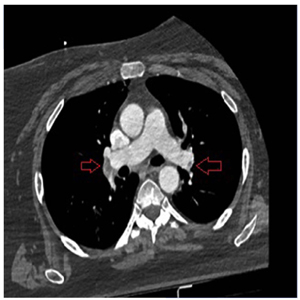A case of massive pulmonary embolism causing cardiac arrest managed with successful systemic thrombolytic in the emergency department

Accepted: 18 November 2022
All claims expressed in this article are solely those of the authors and do not necessarily represent those of their affiliated organizations, or those of the publisher, the editors and the reviewers. Any product that may be evaluated in this article or claim that may be made by its manufacturer is not guaranteed or endorsed by the publisher.
Pulmonary Embolism (PE), when complicated by cardiac arrest, is almost always fatal despite all resuscitative efforts. However, a more favorable is possible when PE is rapidly identified as the cause of cardiac arrest and pulmonary circulation is quickly re-established by specific therapy. A 54-year-old woman was brought to the Emergency Department (ED) by 112 emergency ambulance service with the complaint of shortness of breath that had started 2 hours ago. She developed cardiac arrest while being physical examined 2 minutes after admission, and Cardiopulmonary Resuscitation (CPR) was immediately begun. Massive PE was considered the most likely diagnosis in the light of her history, physical examined, and bedside ultrasonography findings; thus, recombinant tissue Plasminogen Activator (r-tPA) was administered during CPR. The second CPR attempt achieved return of spontaneous circulation within 5 minutes. She was treated at intensive care unit for 32 days and discharged from the hospital with complete recovery.
American College of Emergency Physicians Clinical Policies Subcommittee (Writing Committee) on Thromboembolic Disease, Wolf SJ, Hahn SA, et al. Clinical policy: Critical issues in the evaluation and management of adult patients presenting to the emergency department with suspected acute venous thromboembolic disease. Ann Emerg Med 2018;71:e59-e109. DOI: https://doi.org/10.1016/j.annemergmed.2018.03.006
Konstantinides SV, Meyer G, Becattini C, et al. 2019 ESC Guidelines for the diagnosis and management of acute pulmonary embolism developed in collaboration with the European Respiratory Society (ERS): The Task Force for the diagnosis and management of acute pulmonary embolism of the European Society of Cardiology (ESC). Eur Respir J 2019;54:1901647. DOI: https://doi.org/10.1183/13993003.01647-2019
Uğur H, Yazıcı B, Akçay A, et al. Masif pulmoner embolide başarısız trombolitik tedavi sonrası tekrarlanan uzatılmış trombolitik tedavi. Türk Kardiyol Dergisi 2010;38:432-35
Michael R, Stephen L. Management of massive and submassive pulmonary embolism, iliofemoral deep vein thrombosis and chronic thromboembolic pulmonary hypertension. Circulation 2011;123:1788-830. DOI: https://doi.org/10.1161/CIR.0b013e318214914f
Spöhr F, Böttiger BW. Safety of thrombolysis during cardiopulmonary resuscitation. Drug Saf 2003;26:367-79. DOI: https://doi.org/10.2165/00002018-200326060-00001
Stein PD, Beemath A, Matta F, et al. Clinical characteristics of patients with acute pulmonary embolism: data from PIOPED II. Am J Med 2007;120:871-79. DOI: https://doi.org/10.1016/j.amjmed.2007.03.024
Ryu JH, Pellikka PA, Froehling DA, et al. Saddle pulmonary embolism diagnosed by CT angiography: frequency, clinical features and outcome. Respir Med 2007;101:1537-42. DOI: https://doi.org/10.1016/j.rmed.2006.12.010
Vyas V, Goyal A. Acute pulmonary embolism. [Updated 2021 Aug 11]. In: StatPearls [Internet]. Treasure Island (FL): StatPearls Publishing; 2022 Jan-. Available from: https://www.ncbi.nlm.nih.gov/books/NBK560551/
Hepburn-Brown M, Darvall J, Hammerschlag G. Acute pulmonary embolism: a concise review of diagnosis and management. Intern Med J 2019;49:15-27. DOI: https://doi.org/10.1111/imj.14145
Arboscello E, Ponassi I, Lomeo A, et al. Pulmonary embolism: The role of emergency scan and intervening radiology in medium-high-risk patients with pulmonary embolism. Emerg Care J 2010;6:5-10. DOI: https://doi.org/10.4081/ecj.2010.1.5
Konstantinides SV, Torbicki A, Agnelli G, et al. Task force for the diagnosis and management of acute pulmonary embolism of the European Society of Cardiology (ESC). 2014 ESC guidelines on the diagnosis and management of acute pulmonary embolism. Eur Heart J 2014;35:3033-69, 3069a-3069k.
Matthews JC, McLaughlin V. Acute right ventricular failure in the setting of acute pulmonary embolism or chronic pulmonary hypertension: a detailed review of the pathophysiology, diagnosis, and management. Curr Cardiol Rev 2008;4:49-59. DOI: https://doi.org/10.2174/157340308783565384
Beydilli İ, Yılmaz F, Sönmez BM, et al. Thrombolytic therapy delay is independent predictor of mortality in acute pulmonary embolism at emergency service. Kaohsiung J Med Sci 2016;32:572-8. DOI: https://doi.org/10.1016/j.kjms.2016.09.004
Böttiger BW, Martin E. Thrombolytic therapy during cardiopulmonary resuscitation and the role of coagulation activation after cardiac arrest. Curr Opin Crit Care 2001;7:176-83. DOI: https://doi.org/10.1097/00075198-200106000-00006
Keller K, Hobohm L, Ebner M, et al. Trends in thrombolytic treatment and outcomes of acute pulmonary embolism in Germany. Eur Heart J 2020;41:522-529. DOI: https://doi.org/10.1093/eurheartj/ehz236
Copyright (c) 2022 The Authors

This work is licensed under a Creative Commons Attribution-NonCommercial 4.0 International License.
PAGEPress has chosen to apply the Creative Commons Attribution NonCommercial 4.0 International License (CC BY-NC 4.0) to all manuscripts to be published.


 https://doi.org/10.4081/ecj.2022.10827
https://doi.org/10.4081/ecj.2022.10827







